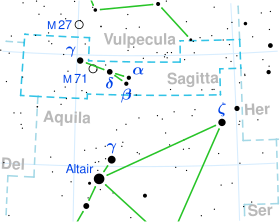| Observation data Epoch J2000.0 Equinox J2000.0 (ICRS) | |
|---|---|
| Constellation | Sagitta |
| Right ascension | 19h 40m 05.7918540977s[1] |
| Declination | +18° 00′ 50.004597761″[1] |
| Apparent magnitude (V) | +4.38[2] |
| Characteristics | |
| Evolutionary stage | bright giant |
| Spectral type | G1 II[3] |
| B−V color index | 0.777±0.014[4] |
| Astrometry | |
| Radial velocity (Rv) | 1.72 ± 0.16[5] km/s |
| Proper motion (μ) | RA: 14.630 ± 0.257[1] mas/yr Dec.: -20.160 ± 0.276[1] mas/yr |
| Parallax (π) | 8.5307 ± 0.1848 mas[1] |
| Distance | 382 ± 8 ly (117 ± 3 pc) |
| Absolute magnitude (MV) | −0.96[6] |
| Details | |
| Mass | 4.11[7] M☉ |
| Radius | 21±2[8] R☉ |
| Luminosity | 340[3] L☉ |
| Surface gravity (log g) | 3.11[3] cgs |
| Temperature | 5,333[3] K |
| Metallicity [Fe/H] | −0.15[3] dex |
| Rotational velocity (v sin i) | 10[9] km/s |
| Age | 151[7] Myr |
| Other designations | |
| Database references | |
| SIMBAD | data |
Alpha Sagittae, formally named Sham /ˈʃæm/,[11][12] is a single[13] star in the northern constellation of Sagitta. Alpha Sagittae is the Bayer designation, which is latinized from α Sagittae and abbreviated Alpha Sge or α Sge. It is visible to the naked eye as a yellow-hued star with an apparent visual magnitude of +4.38.[2] Despite the name, this is not the brightest star in the constellation – that distinction belongs to Gamma Sagittae. Based upon parallax measurements, Alpha Sagittae is approximately 382 light-years from the Sun. It is moving further away from the Earth with a heliocentric radial velocity of 1.7 km/s.[5]
This is an evolved bright giant with a stellar classification of G1 II.[3] It is 151[7] million years old with 4[7] times the mass of the Sun and has expanded to around 21[8] times the Sun's radius. It is radiating 340 times the Sun's luminosity from its enlarged photosphere at an effective temperature of 5,333 K.[3] There is an X-ray source within 12″ of these coordinates.[14]
The evolutionary state of Alpha Sagittae is unclear. Its temperature and luminosity place it within the Hertzsprung gap, a region of the H-R diagram where stars more massive than the sun are evolving rapidly away from the main sequence towards becoming red giants. However, the chemical composition of its surface indicates that it has already experienced the first dredge-up of fusion products that occurs soon after a star reaches the red giant branch. It also lies within the Cepheid instability strip, but is not a Cepheid variable.[15] It belongs to a small group of known stars that have been called carbon-deficient red giants and may have experienced binary mass exchanges.[16]
- ^ a b c d e Brown, A. G. A.; et al. (Gaia collaboration) (August 2018). "Gaia Data Release 2: Summary of the contents and survey properties". Astronomy & Astrophysics. 616. A1. arXiv:1804.09365. Bibcode:2018A&A...616A...1G. doi:10.1051/0004-6361/201833051. Gaia DR2 record for this source at VizieR.
- ^ a b Cite error: The named reference
tycho2was invoked but never defined (see the help page). - ^ a b c d e f g Cite error: The named reference
aaa352_495was invoked but never defined (see the help page). - ^ Cite error: The named reference
Anderson2012was invoked but never defined (see the help page). - ^ a b Cite error: The named reference
soubiranwas invoked but never defined (see the help page). - ^ Cite error: The named reference
kovtyukhwas invoked but never defined (see the help page). - ^ a b c d Cite error: The named reference
takedawas invoked but never defined (see the help page). - ^ a b Cite error: The named reference
vanBelle2009was invoked but never defined (see the help page). - ^ Cite error: The named reference
BoehmVitense2004was invoked but never defined (see the help page). - ^ "5 Sge". SIMBAD. Centre de données astronomiques de Strasbourg. Retrieved 2019-03-30.
- ^ Kunitzsch, Paul; Smart, Tim (2006). A Dictionary of Modern star Names: A Short Guide to 254 Star Names and Their Derivations (2nd rev. ed.). Cambridge, Massachusetts: Sky Pub. ISBN 978-1-931559-44-7.
- ^ Cite error: The named reference
IAU-LSNwas invoked but never defined (see the help page). - ^ Cite error: The named reference
Eggleton2008was invoked but never defined (see the help page). - ^ Cite error: The named reference
Greiner2015was invoked but never defined (see the help page). - ^ Vanture, Andrew D.; Wallerstein, George (1999). "Carbon, Nitrogen, and Oxygen Abundances of Selected Stars in the Hertzsprung Gap". Publications of the Astronomical Society of the Pacific. 111 (755): 84. Bibcode:1999PASP..111...84V. doi:10.1086/316306.
- ^ Bond, Howard E. (2019). "Carbon-deficient Red Giants". The Astrophysical Journal. 887 (1): 12. arXiv:1910.06256. Bibcode:2019ApJ...887...12B. doi:10.3847/1538-4357/ab4e13. S2CID 204512549.
